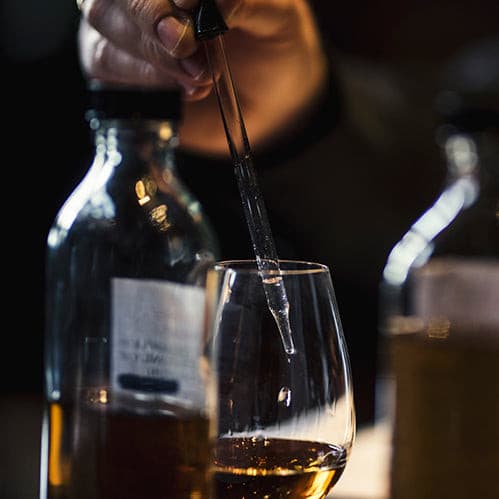Last week I had the chance to sit down with Jenna Elie (@whiskyagogirl) for a live discussion about whisky appreciation on our YouTube channel. If you were unable to join us, you can watch the video here: How to Taste Whisky Like A Pro. One of the many subjects we discussed was the idea of adding water to your whisky to optimize the tasting experience.
This has become a bit of a debate among whisky drinkers over the years. Some will insist that whisky, particularly single malt whisky, should always be enjoyed with 1-2 drops of water. Others claim that adding any water at all is sacrilege. But does adding water really change the whisky tasting experience? And how much water should be added, if at all?
Of note, the majority of single malt Scotch whisky on the market today is already watered down prior to bottling. Distillers dilute the spirit before it is sold in effort to achieve a desired flavor profile and make it easier to drink. At The Scotch Malt Whisky Society, we bottle whisky at natural cask strength. This means that the spirit has not been diluted prior to bottling and as such, will have a much higher alcohol content and concentration of flavor. This is one reason why cask strength whisky is often more expensive than regular single malts.
When it comes to nosing and tasting cask strength whisky, I often use water as a key for unlocking the full aroma and flavor potential of the spirit. A study conducted by a group of chemists in Sweden has concluded that adding water to whisky will disrupt the main compound of guaiacol and ethanol. Guaiacol is largely responsible for the smoky aromatics and flavors within the whisky itself. Researchers found that by adding water, the guaiacol molecules are severed from the ethanol molecules, subsequently rising to the surface of the glass, carrying the spirit’s aromas and flavors with them.
World-renowned whisky writer and Society Chair Charlie MacLean explains,
“If you reduce the strength on the bottling line, a lot of the molecules that contribute to flavor disappear. They become volatile. If you bottle at high strength and then add water in the glass, then you get the benefit of the volatile molecules when you smell and perhaps even more important, it makes it much easier to taste and to hold in the mouth”.
So, how much water should one add to their whisky? For me, that decision will largely depend on several factors including the whisky’s unique profile and, well, my own personal palate. I often like to recommend what is called the blink test. I start by tasting the whisky neat. If the alcohol forces me to blink, that’s usually a sign that my mind is more focused on fending off the high proof of the alcohol rather than the flavors of the spirit itself. I generally enjoy my whisky at a point where the alcohol is present but not so strong that it distracts me from tasting all of the flavors being offered.
Take for instance Cask 48.82 Vivacious, zesty and penetrating. This is a 12-year-old Speyside whisky bottled at 57.5%. At natural cask strength, the spirit is exactly as the name suggests. It’s a bright, lively and rather intense spirit. The aroma and flavor profile is sweet and fruity but much of that can be masked by the sheer octane of the alcohol. Adding a dash of water to this whisky will subdue the heat of the alcohol and release more of its orchard fruit and honey notes.
With this particular whisky I’ve added 5-6 drops per 1 oz and to me, this is where this particular whisky really shines. Your palate may prefer it with a few more drops or perhaps at natural cask strength. Finding your own equilibrium takes a bit of practice but once you get there, I think you will find it quite rewarding.
Let’s look at one more whisky. Cask 7.198 Sweet summer berries is a 24-year-old Speyside whisky bottled at 51.6%. The whisky is twice as old as the previous 48.82 and the alcohol content is lower but not by much. When I taste this whisky neat, I find it to be a very elegant and complex spirit that is a bit more approachable out of the cask than 48.82, also a 12-year-old. The profile contains gentle notes of fresh pear, vanilla bean and old leather. When I add a few drops of water, the whisky becomes less earthy and a bit more floral. While I tend to enjoy it both with or without water, I happen to prefer this particular whisky neat.
So to sum it all up, don’t be afraid to add water to your whisky. I would encourage you to go out and try it for yourself. Taste the whisky neat and see how it changes with a dash of water. The ability to find our own equilibrium is part of what makes cask strength whisky interesting and fun. It’s a very personal experience that we can customize to our own liking.



